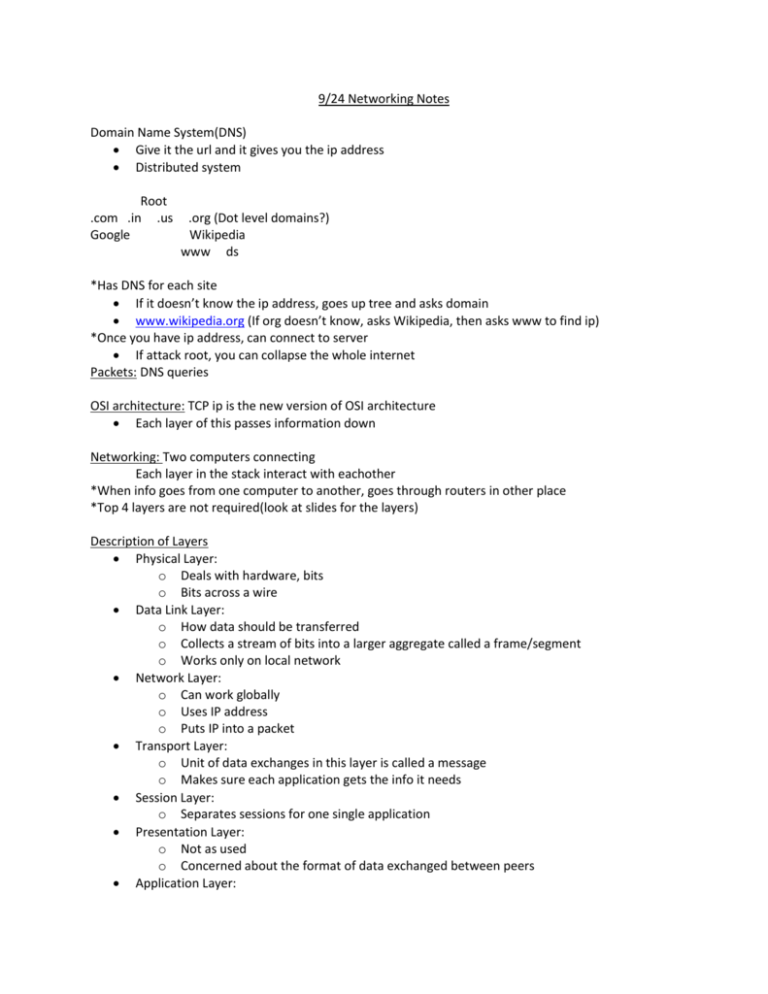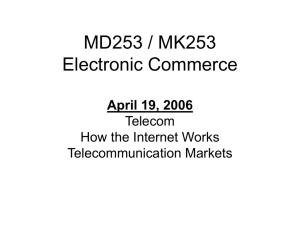9/24 Networking Notes Domain Name System(DNS) Give it the url
advertisement

9/24 Networking Notes Domain Name System(DNS) Give it the url and it gives you the ip address Distributed system Root .com .in .us Google .org (Dot level domains?) Wikipedia www ds *Has DNS for each site If it doesn’t know the ip address, goes up tree and asks domain www.wikipedia.org (If org doesn’t know, asks Wikipedia, then asks www to find ip) *Once you have ip address, can connect to server If attack root, you can collapse the whole internet Packets: DNS queries OSI architecture: TCP ip is the new version of OSI architecture Each layer of this passes information down Networking: Two computers connecting Each layer in the stack interact with eachother *When info goes from one computer to another, goes through routers in other place *Top 4 layers are not required(look at slides for the layers) Description of Layers Physical Layer: o Deals with hardware, bits o Bits across a wire Data Link Layer: o How data should be transferred o Collects a stream of bits into a larger aggregate called a frame/segment o Works only on local network Network Layer: o Can work globally o Uses IP address o Puts IP into a packet Transport Layer: o Unit of data exchanges in this layer is called a message o Makes sure each application gets the info it needs Session Layer: o Separates sessions for one single application Presentation Layer: o Not as used o Concerned about the format of data exchanged between peers Application Layer: o Standardized common type of exchanges IP-> network layer FTP,HTTP,NV,TFTP-> application layer *IP helps two computers communicate IP service Model Packet delivery model o Connectionless model for data delivery Packet Format Pieces to address memory Every packet that comes to a layer must have a header o Shows where you send it, where it comes from TTL-> how many hops it made Length-> bits in a whole packet ICMP If a machine cannot do work, sends message to inform the sender o This message is an ICMP message Ping->checks to see if server is alive or not If you get no reply, it is not alive ICMP Attack Surf attack(denial of service) Overload the server by replies from other servers Reliable Byte Stream(TCP) Transmission control protocol(TCP) offers the following services o Reliable, connection oriented, byte-stream service Streams movies Flow Control: Preventing senders from overrunning capacity Congestion Control: Preventing too much data from being injected into network Sliding window: Send packets from A to B then B sends confirmation and update on how many packets it can receive Slide window over in A till all the packets are sent TCP Segment: Buffers the stack and creates a segment TCP Header: 6 bit flags o SYN, FIN,RESET, PUSH, URG, ACK *TCP slows packet sending down











